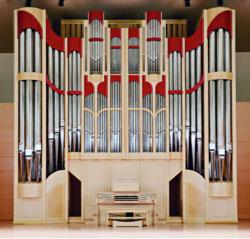
The Music Department at University of Nevada, Las Vegas, and the Rudolf von Beckerath Company of Hamburg, Germany, will celebrate the completion of the restoration of the 53-rank Maureen Jackson Smith Memorial Organ built by that firm in 2004 with a gala re-inauguration recital sponsored by the Southern Nevada AGO chapter on October 11 at 7:30 p.m. in Doc Rando Recital Hall on the university campus in Las Vegas. (See The Diapason, July 2007, cover feature.)
On May 24, 2012, a failed sprinkler head on the stage of Doc Rando Hall rained down water on the instrument for 20 minutes before the system could be shut off, causing extensive damage. Restoration work included replacement of Great, Positiv, and Pedal chests, all trackers, the console, some wooden pipes, and the entire façade of the instrument. A team from Beckerath, headed by Holger Redlich, manager of the company, came in January 2013 to prepare the instrument for the restoration work that would follow in May. The recital hall remained in full operation during the spring academic term.
Five artisans from Beckerath arrived at the end of May and completed the work in early July. The restoration process involved many people from the university; Jonathan Good, Chair of the Department of Music, coordinated that effort. Formal acceptance of the restored organ occurred on July 4. Insurance covered the cost of
the restoration.
Isabelle Demers, who had presented a recital on the instrument just two weeks prior to the disaster, will be the featured artist at the October 11 gala. Her program will be the first in the Southern Nevada chapter’s 2013–14 organ recital series. Other performers scheduled for the season are Jonathan Dimmock, Pamela Decker, and Nathan Laube.
For information: www.sncago.org.
—Paul S. Hesselink

